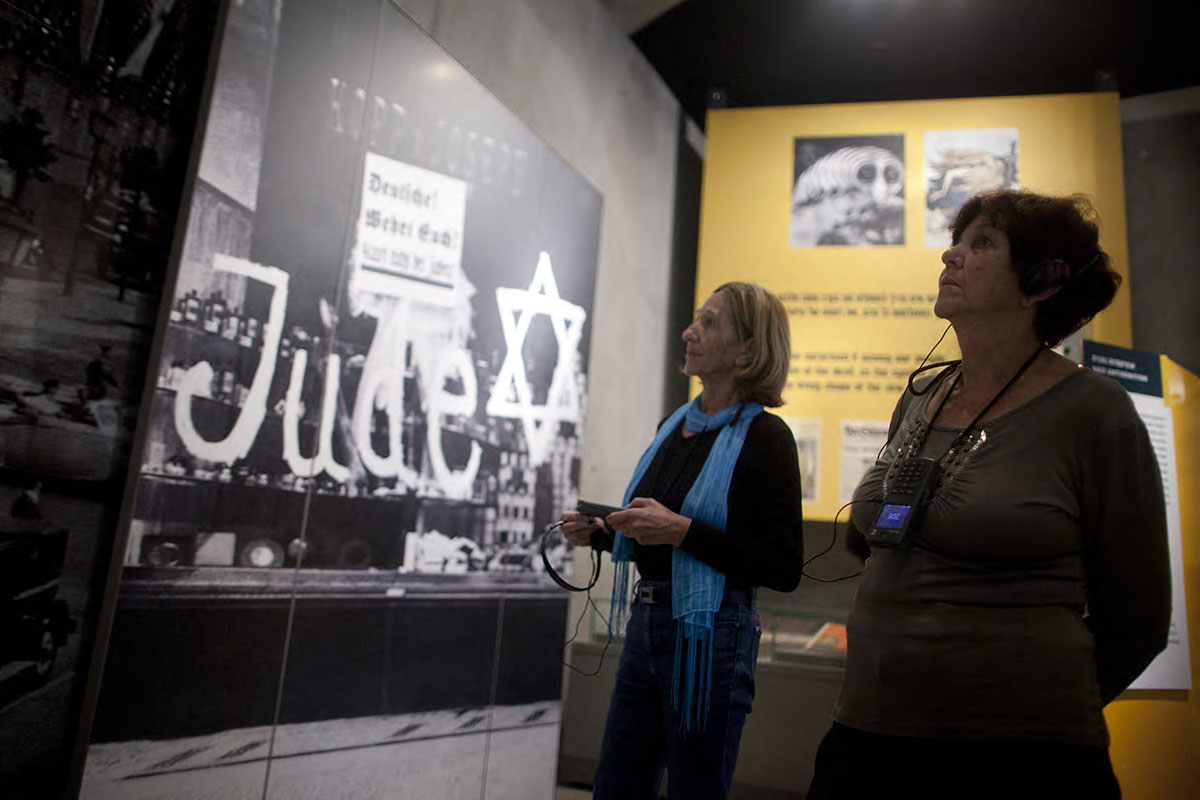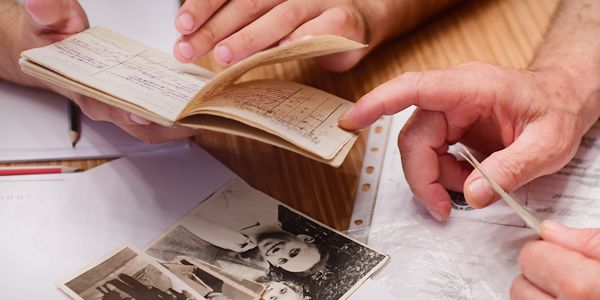- Part of the documentation can be found in the collection compiled by the author, dealing with the life of the Jews in small communities. The documents were catalogued by Yad Vashem and are now in the Institute for Contemporary Jewry, Hebrew University of Jerusalem (henceforth: Kaufman Collection). The documents were collected with the active assistance of Dr. Ernst Jacobi, the director of the Advisory Office for the Preservation of Communal Archives in the State of Hessen, Federal Republic of Germany (Beratungsstelle fuer Gemeindearchivpflege des Hessischen Landkreistages).
- On the difficulties involved in interviewing non-Jews on the events during the period in question, see Angelika Schleindl, Verschwundene Nachbarn.
- Die Lageberichte der Geheimen Staatspolizei ueber die Provinz Hessen-Nassau 1933-1936, Koeln-Wien,1986 (henceforth: Gestapo Reports for Hessen-Nassau).
- One of the non-Jewish interviewees reported: "Our Jews lived modestly, dealt in cattle and kept small stores." See Kaufman Collection, 072/62. Josef Menz, "Zur Judengeschichte, in Wuestensachsen mitgeteilt von einem Zeitzeugen," Kaufman Collection, 072/62. See also interview with Hanan Aynor, May 1991, Oral Documentation Section, Institute for Contemporary Jewry (henceforth: Interview with Aynor). Information about the occupations of Jewish residents can be found in most of the relevant documents discussed in this article, Kaufman Collection.
- On industrial enterprises established in small towns, see testimony of Ernst Kahn on the shoe factory in the town of Bad-Homburg. See also A. J. Peck and U. D. Herschler, Queen City Refuge, West Orange, New Jersey, 1989 (henceforth: Peck-Herschler). See also H. G. Vorndran und Juergen Ziegler, "Juden in Gross-Gerau, oder: Wie die Heimat zur Fremde wurde," in: Juden in Gross-Gerau, Eine lokale Spurensuche, 1989 (henceforth: Ziegler); Menahem Kaufman, "Die Juedische Gemeinde in Gross-Gerau" (henceforth: Kaufman, Gross-Gerau). On small industrial plants owned by Jews in Kurhessen, see Gestapo reports for October 1933 and April 1934, Gestapo Reports for Hessen-Nassau, pp. 71, 89.
- On the integration of the Jews into the town and village society, see a letter of Maria Fischer, from November 10, 1988, Babenhausen documents, Kaufman Collection 072/48; testimony of Ernst Katz of Hungen, ibid. , 072/11. See also K. H. Doernbecker, "Die Juden in Ziegenhain in den dreissiger Jahren unseres Jahrhunderts" (henceforth: Ziegenhain), ibid. , 072/20; Brunhilde Hoffen, Es geschah unter uns , Obererlenbach, 1988 (henceforth: Hoffen/Obererlenbach), ibid. , 076/76; Fritz Engel, Zur Geschichte der Juden in Ortenburg, 1981 (henceforth: Engel/Ortenburg), ibid. , 072/71; Lich, 1933- 1945, Eine Dokumentation (henceforth: Lich). According to this document, the Jews maintained good relations with their neighbours until 1925, when Hindenburg was elected president of the Reich for the first time. Later the situation deteriorated, ibid. , 072/80. According to Zwingenberg documents (henceforth: Zwingenberg), p. 379, the Jewish residents of this town were well integrated into local society. Most were poor, though self-respecting people, ibid. , 072/83. See also testimony of Spiegel of Hildres, ibid. , 072/88. On antisemitism in the 1920s, see testimony of Ernst Katz of Hungen, ibid. , 072/11. See also Naftali H. Sonn und Otto Berger, "Schicksalswege der Juden in Fulda und Umgebung" (henceforth: Sonn-Berger, Fulda), p. 158, Fulda documents, ibid., 072/68. In Gedern in the 1920s the Jews were accused of taking over peasant houses and running their businesses in a "typically Jewish" fashion, see Erwin Diel, "Zusammenleben in Gedern" (henceforth: Diel/Gedern), ibid. , 072/75. Liselotte Stube Wieland recounted her grandfather's fierce antisemitism in the town of Homburg throughout the Weimar period, Liselotte Stube Wieland, "Die Lektion gelernt," Homburger Hefte , 28/1986 (henceforth: Stube Wieland), p. 15, ibid. , 072/58.
- Werner J. Cahnman, "Village and Small-Town Jews in Germany," in: German Jewry, Its History and Sociology, New Brunswick (USA) and Oxford (UK), 1989 (henceforth: Cahnman), pp. 51-65. In addition to this theoretical analysis, see Cornelia Ruehlig und Inge Auer, Die schlimmste Sache war die Angst, die andauernde Angst. Alltagsgeschichte der juedischen Familien in Moerfelden Walldorf 1918-1942, Moerfelden/Walldorf, 1986 (henceforth: Ruehlig-Auer), pp. 34-36, 42-46, 188; Schleindl, p. 92; see also Das Schicksal der Hadamarer Juden (mimeograph), Kaufman Collection 072/21 (henceforth: Hadamarer Juden), pp. 4-5. On the extent of the integration of Jewish peasants into village society in Woelfersheim, see a survey on the Rossmann family (henceforth: Rossmann), a mimeograph in the possession of the author. Also based on personal recollections of the author.
- Ruehlig-Auer, p. 42; Erinnerungen an juedische Mitbuerger, von Michael, Erster Beigeordneter 23 Feb. 1988, Wehrheim, Kaufman Collection 072/82; Cahnman, pp. 52-56; testimony of E. Katz, Hungen documents, Kaufman Collection 072/11; Oberbrechen documents, ibid. , 072/63, Diel/Gedern, ibid. , 072/75; Zwingenberg, ibid. , 072/83.
- Thomas V. Lummitsch, Uebersicht ueber christlich-juedisches Zusammenleben in Gedern (henceforth: Lummitsch/Gedern), p. 11, ibid. , 072/75.
- Thus, for example, in the village of Ziegenhain, seven Jews, i.e., 10 percent of the total Jewish population of the village fell on the battlefield during World War I, Ziegenhain, Kaufman Collection 072/20. In his testimony on March 3, 1989, Paul Hess, a non-Jew, reported on the close relations resulting from the shared fate during the war. See Griesheim documents, ibid. , 072/71.
- Testimony of E. Katz, Hungen documents, ibid. , 972/11; in Ortenberg Jewish soloists sang with the Protestant Church choir, especially during Christmas, see Ortenberg, ibid. , 72/71; also recollections of author.
- Menahem Kaufman, "Juedische Kindheit und Jugend in Deutschland," in: Juden in Gross-Gerau (henceforth: Kaufman-Jugend), p. 42; see also Interview with Aynor, and Cahnman, p. 58.
- Ibid ., p. 61; Babenhausen, Kaufman Collection 072/48; Ernst Katz was enrolled at the secondary school (Oberrealschule) in the nearby town, Hungen documents, ibid. , 072/11; see interview with Aynor, also based on the author's recollections.
- Engel related, inter alia , that the Jews had avoided political involvement; Engel/Ortenberg, ibid. , 072/71. Regarding the request of the district chief (Landrat) from February 15, 1934, the Buergermeister of Fritzlar reported on February 23, 1934: "The Jews have adjusted to the new situation in the town. They had not engaged in political activity in the past either." ibid ., 072/51. Similarly, the Jewish residents of the village of Geinsheim and the town of Gross-Gerau were not involved in political activities. Also based on the author's recollections. On the reluctance of Jewish villagers to become involved in politics, see Rossmann mimeograph in the possession of the author. As for exceptions to this rule: in Gedern Jews played an important role in the Social-Democratic party. Fifteen percent of the party members were Jews, whereas the percentage for the general was 6.6%. See Diel/Gedern, Kaufman Collection 072/75. In the small town of Oppenheim, attorney Artur Bockmann served on the municipal council on behalf of the SPD and was sent to the Osthofen concentration camp in May 1933. See Dokumentation der Oppenheimer und Niersteiner Juden, Kemp, 1990 (henceforth: Oppenheim und Nierstein), p. 6, Kaufman Collection.
- Cahnman, p. 58; the registrar of Oberbrechen maintains that the tension between the Jewish residents and their neighbours was not racial in nature, but stemmed from the ordinary tensions of everyday life in the village. See Eugen Caspari, Juedische Buerger in Oberbrechen waehrend der Weimarer Republik und in der Nationalsozialistischen Diktatur Giessen , Brechen-Oberbrechen, 1975 (henceforth: Caspari/Oberbrechen), p. 58.
- Stube Wieland, p. 15, ibid. , 072/58.
- Regarding the fears of a Jewish young man who intended to marry a Gentile woman in one of the villages of the region, see Interview with Aynor. In Oppenheim there was one mixed couple, and in Nierstein on the Rhein two couples; on their fate under the Nazi regime, see Oppenheim and Nierstein, pp. 60-66, Kaufman Collection.
- Cahnman, p. 62. One of the residents of Babenhausen said of the Jews living in the village that they were "people like us, though with strange characteristics"; see Aus den Erinnerungen eines Babenhausner Buergersohnes , Babenhausen, Kaufman Collection 072/75.
- Cahnman, pp. 55-58; Interview with Aynor; testimony of Yochanan Hans Oppenheimer of Nahariya, Israel: Zahlen und Fakten ueber die letzten Jahre der Juden in Langsdorf , Langsdorf documents, Kaufman Collection 072/75.
- On a failed match of this kind and the outcome, see Interview with Aynor; on troubled relations between Jewish families in Langsdorf, and on the Oppenheimer family, see Langsdorf documents, as well as the author's recollections.
- Ruehlig-Auer, p. 43, 185; testimony of the Neu brothers, p. 198; see also Stephan Kolb, Die Geschichte der Bad Nauheimer Juden, Bad Nauheim, 1987 (henceforth: Kolb), p. 133; testimony of E. Katz in: Die Geschichte der Juden aus Hungen, 1988 (henceforth: Hungen A), p. 13; see also Kaufmann-Jugend, pp. 42-43, and Interview with Aynor.
- Ulrich Dunker, Der Reichsbund juedischer Frontsoldaten 1919-1938, Geschichte eines juedischen Abwehrvereins, Duesseldorf, 1977. On the establishment of the RJF branch in Gedern, see Lummitsch/Gedern, Kaufman Collection 72/75; Chaim Weizmann, who stayed in the town of Pfungstadt in the years 1892-1893, reported on the German patriotism of the Orthodox Jews there; see Yehuda Reinharz, Chaim Weizmann – the Making of a Zionist Leader, New York, 1985, p. 28; on the connection with the place called Heimatbewusstsein, see Caspari/Oberbrechen, Kaufman Collection 072/63.
- Ruehlig-Auer, p. 49; Kolb, p. 133; Schleindl, p. 41, 151; Cahnman, p. 60; Ziegler, pp. 25-26; see also Jisk Steeskamp, Die Evangelische Kirchengemeinde Gross-Gerau und die Juden 1910 bis 1938, p. 49, in: Juden in Gross-Gerau (see note 5) (henceforth: Steeskamp); Kaufmann-Jugend, p. 43.
- Scriba's detailed report on the incident can be found in Chronicles of the Church, pp. 423-424, see Steeskamp, p. 50.
- According to Engel, the Ortenburg Jews sympathized with the "Freisinn" movement and later voted for the Demokratische Staatspartei, known also as Deutsche Staatspartei; see Kaufman Collection 072/71. In the Reichstag elections the Jewish vote went to different parties, including the German nationalist right; therefore, one may only point to overall trends, without solid statistical proof. According to Aynor, some Jews even voted for the Catholic political party Zentrum; Interview with Aynor.
- On the harassment of Jews in the Catholic village of Gersfeld in the Fulda district before 1933, seHans Wilde, "Die Juden in Gersfeld" (henceforth: Gersfeld). Wilde maintains that, as in other villages, Gersfeld was controlled by the Nazis even before 1933; Kaufman Collection 072/58.
- The registrar of the town of Obererlenbach, B. Hoffen, related the following: "The situation was different. In some places the Jews could carry on somehow up to 1938 amidst the local population, but in some settlements the terror was unleashed at a very early stage." Hoffen/Obererlenbach, ibid. , 072/76. The Nazi Buergermeister who protected the Jews of his village was Hugo Trost. He had been influenced by his mother, a close friend of the local Jews. See Caspari/Oberbrechen, ibid. , 072/63.
- Ruehlig-Auer, pp. 66, 113, 206. For information about Sprendlingen, see Die Sprendlinger Juden, Dreieich, 1983 (henceforth: Sprendlingen), Kaufman Collection 072/65.
Sunday to Thursday: 09:00-17:00
Fridays and Holiday eves: 09:00-14:00
Yad Vashem is closed on Saturdays and all Jewish Holidays.
Entrance to the Holocaust History Museum is not permitted for children under the age of 10. Babies in strollers or carriers will not be permitted to enter.






